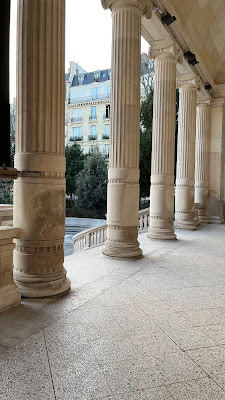I discovered the Palais Galliera when we were in Paris in 2018 and I had more time to explore all the treasures Paris has to offer. The Palais Galliera is the Musée de la Mode de la Ville de Paris or the fashion museum. The Palais was built in the Beaux-Arts style at the end of the 19th century for the Duchess of Galliera to house her art collection. She intended to donate the palace and her artwork to the French State after her death.
 |
| Side View of Palais Galliera |
However, her lawyer made a mistake in the documentation and donated it to the City of Paris rather than France. Oops. The Duchess was not happy and tried to change it to the French State but to no avail. In 1886, before the palace was finished, the French Republic adopted a law expelling any person who was a direct heir of a royalist dynasty that had reigned in France. She was descended from the House of Orléans and was outraged by the law. It felt like a slap in the face because she had previously donated the Hôtel Matignon to France, which is the home of the Prime Minister of France. She was unable to revoke her gift of the new museum, so she abandoned the rest of her planned gift to Paris and bequeathed her entire art collection to the Palazzo Rosso in Genoa, Italy. The result was Paris received only an empty Palais Galliera.
 |
| Courtyard |
 |
| Entrance to Palais Galliera |
The Galliera originally housed temporary exhibits and then became the home of the Museum of Industrial Arts (Arts et Métiers) in 1903. Later modern art exhibits and auctions were held there. In 1977, the Fashion and Costume Museum of the City of Paris moved from the Musée Carnvalet to the Palais Galliera and restoration workshops were built in the basement. In 1997, it was renamed the Musée de la Mode de la Ville de Paris. The museum now has an arrangement with designers to have them donate some of their couture collection to the museum each season.
I came to see the 100 years of French Vogue exhibit. The magazine was started by Condé Nast in 1920 and was independent of its Vogue magazine in the US. The entry to the exhibit displayed all 100 covers.
Originally, all the covers were illustrated rather than using photographs. It was interesting to see the change in style and feel through the century.

 |
|

 |
|

On the back of each cover was "Vogue's Viewpoint." It is the only column that has continued since the very beginning of the magazine. The editorials reveal the evolution of the magazine and fashion over time.
 |
Yves Saint Laurent
|
 |
Audrey Hepburn and
husband Mel Ferrer |
 |
| So elegant! |
The Viewpoint below describes how skirts in 1953 are the shortest they've been since World War II - 50 centimeters from the ground! It is important to have "impeccable legs, delicate ankles and perfect stockings." And this Vogue issue, starting on page 177, will advise you just how to achieve that!
It was interesting to see how Vogue changed over time from illustrations and studio photography to outdoor photography.
 |
Autumn in Paris at
Place Vendôme 1932 |
 |
| 1932 |
 |
1928
Studio Photography that appears to be outdoors |
The magazine had to shut down during World War II because of supply issues leading up to the war and then the Germans withheld permission to publish. The last issue published before the war in 1939 was hand drawn and lettered.
 |
| December 1939 Cover |
Vogue began publishing special editions beginning in 1945 and by 1947 was again publishing monthly. More of the photography was taken outside and showed off Paris.
 |
| 1947 |
 |
| 1951 |
 |
| 1951 |
 |
| 1950 Evening Dress |
The displays included the actual clothes paired with the illustration.
 |
| 1947 |
 |
| Courrèges |
As a seamstress, I loved seeing the handwork on the actual clothing, including the beautiful bound buttonholes on the jacket.
 |
1958
"Soulier Séducta"
|
 |
1958
|
 |
| 1961 |
The 1960s celebrated youth. More Vogue articles were aimed at those under 20. New ready-to-wear brands challenged haute-couture houses. A new generation of models, including Twiggy, epitomized the young independent woman. Starting in the 1960s young actresses regularly posed for the cover. Celebrities were also featured in the magazine beginning in the 1960s.
 |
| Barbra Streisand 1966 |
 |
| Twiggy in 1967 wearing Lanvin |
 |
| Yves Saint Laurent 1962 |
 |
| Courrèges 1965 |
 |
| 1969 |
 |
| 1970s Collage Illustration |
 |
| Mick Jagger and Jerry Hall 1996 |
 |
| Actor Gérard Depardieu 1994 |
Catherine Deneuve, the French actress, posed for 16 Vogue covers between 1962 and 2003. She was only 18 years old when she first appeared on the cover.
 |
| Catherine Deneuve |
And between 1994 and 2019, Kate Moss appeared on 21 covers. In 2001, the editor-in-chief declared, "She's the stuff of dreams because she has imperfections like everyone else, even though she's perhaps the biggest fashion icon in the world."
 |
Kate Moss 2009
|
 |
| 2000s |
 |
| Sasha Pivovarova 2008 |
I enjoyed an afternoon walk through time with Vogue. Paris has so many treasures to discover that are just a bit off the beaten path.













































So interesting seeing the history of Vogue and how they depicted their images over time. I have to say, my favorite would be either Mick Jagger or Barbra Streisand. Lovely post.
ReplyDelete